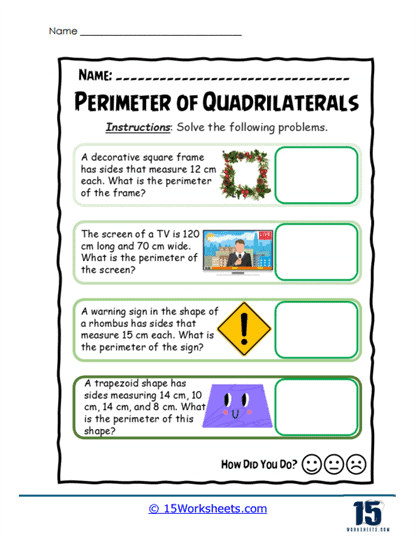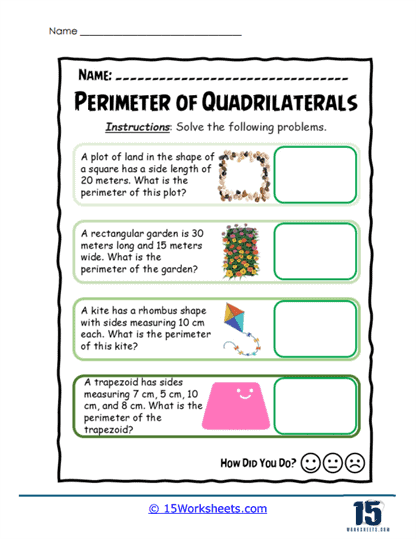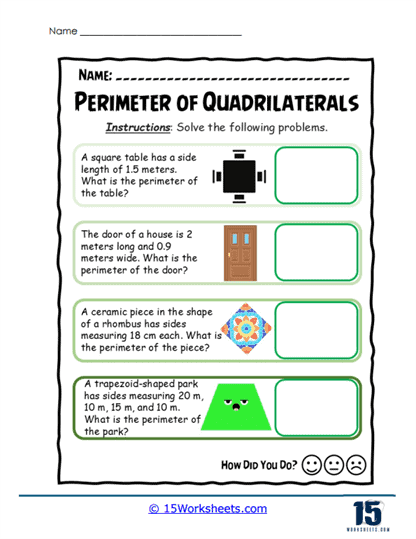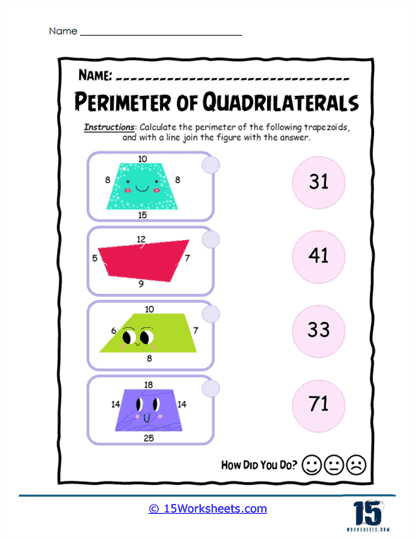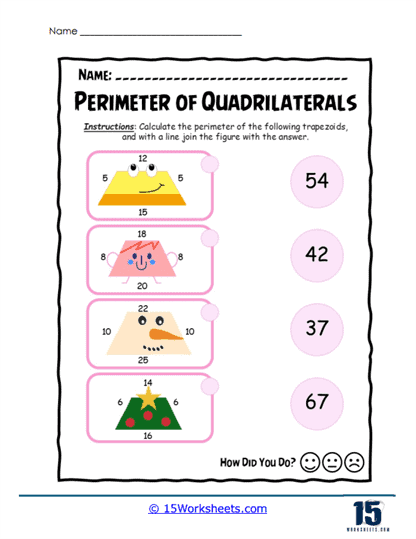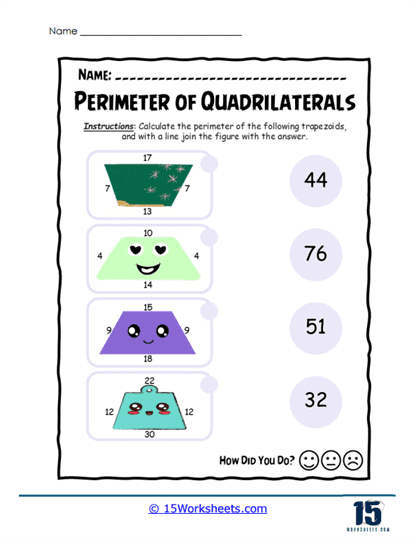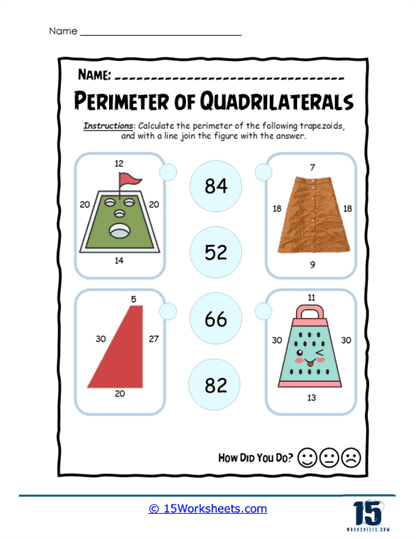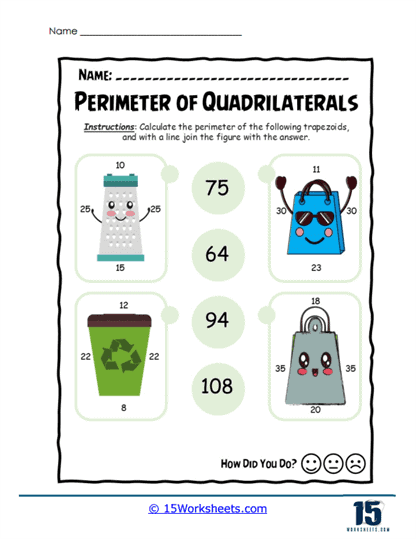Quadrilaterals Worksheets
About Our Perimeter of Quadrilaterals Worksheets
These worksheets will help students understand and practice calculating the perimeter of four-sided shapes. These worksheets include a variety of quadrilateral types, such as squares, rectangles, parallelograms, trapezoids, and rhombuses. They introduce students to the concept of perimeter as the total distance around the shape, reinforcing the idea through diagrams, formulas, and word problems. By working through different exercises, students gain confidence in applying the correct perimeter formulas based on given side lengths.
These worksheets present problems in different formats, including simple numerical calculations, fill-in-the-blank exercises, and real-life application problems. Some worksheets provide all the side lengths, while others challenge students to find missing sides using algebraic expressions or given conditions. This variety ensures that students not only memorize formulas but also develop problem-solving skills. Many worksheets also incorporate step-by-step guides or example problems to help students understand the process before attempting exercises on their own.
A key benefit of these worksheets is that they cater to different learning levels. For younger students, worksheets might focus on basic shapes like squares and rectangles with whole-number measurements. More advanced worksheets, suitable for older students, may include irregular quadrilaterals or require using algebra to determine unknown side lengths. Some worksheets also incorporate word problems to help students connect mathematical concepts to real-world situations, such as fencing a garden or measuring a picture frame.
They provide structured practice, reinforce classroom learning, and help assess a student’s understanding of perimeter calculations. Whether used for homework, classwork, or extra practice, these types of worksheets play a crucial role in building foundational geometry skills that students will use in more advanced math topics.
In the world of geometry, quadrilaterals play a crucial role in helping students develop spatial awareness and problem-solving skills. One fundamental concept related to quadrilaterals is perimeter-the total distance around a four-sided shape. Understanding how to calculate the perimeter of quadrilaterals is not just a theoretical exercise but a practical skill applicable in various real-world scenarios, such as measuring fences, constructing buildings, or designing layouts.
What Are Quadrilaterals?
A quadrilateral is a four-sided polygon with four vertices and four angles, where the sum of its interior angles always equals 360°. Quadrilaterals come in various types, each with unique properties. A square has four equal sides and four right angles, while a rectangle also has four right angles but only opposite sides are equal. A parallelogram has opposite sides that are both equal and parallel, whereas a rhombus has all sides equal but angles that may not be 90°. A trapezoid (or trapezium) has only one pair of parallel sides, and a kite has two pairs of adjacent equal sides. These shapes are fundamental in geometry and are widely used in real-world applications like architecture, engineering, and design.
Here are the most common types:
Square – Four equal sides and four right angles (90°).
Rectangle – Opposite sides are equal, and all angles are 90°.
Parallelogram – Opposite sides are parallel and equal, but angles are not necessarily 90°.
Rhombus – All four sides are equal, but angles may not be 90°.
Trapezoid (US) / Trapezium (UK) – Only one pair of opposite sides is parallel.
Kite – Two pairs of adjacent sides are equal.
How to Find the Perimeter of a Quadrilateral
Perimeter = Sum of all four side lengths
To find the perimeter of a quadrilateral, simply add the lengths of all four sides together. The general formula is P = Side1 + Side2 + Side3 + Side4. However, different types of quadrilaterals have specific formulas that simplify the calculation. For a square, the perimeter is P = 4 × side, since all four sides are equal. In a rectangle, the formula is P = 2 × (length + width) because opposite sides are equal. A parallelogram follows P = 2 × (base + side), and for a trapezoid, where only one pair of sides is parallel, the perimeter is P = Base1 + Base2 + Side1 + Side2. No matter the quadrilateral type, always ensure all side lengths are in the same unit before adding them to get the total perimeter.
When Do We Calculate Perimeter of Quadrilaterals in the Real World?
Determining the perimeter of quadrilaterals is essential in many real-world applications, particularly in fields like construction, landscaping, and interior design. For instance, when building a fence around a rectangular yard or property, knowing the perimeter helps calculate the total length of fencing material needed. Similarly, in home improvement projects such as installing baseboards, framing a wall, or laying down carpeting, measuring the perimeter ensures the correct amount of materials is purchased, reducing waste and additional costs. In road construction, the perimeter of rectangular or trapezoidal plots is used to determine the required materials for curbs, sidewalks, and boundaries. Without accurate perimeter measurements, these projects may face inefficiencies, material shortages, or unexpected expenses.
Another critical area where perimeter measurements play a crucial role is in event planning and logistics. For example, when setting up a stage, dance floor, or exhibition booth, knowing the perimeter helps determine the amount of decorative materials, barricades, or lighting needed to enclose the space. Similarly, in sports, the perimeter of playing fields or courts-such as a soccer field or basketball court-helps in marking boundaries and ensuring regulation-sized layouts. In the fashion and textile industry, the perimeter of quadrilateral fabrics is measured to create patterns for clothing, curtains, or upholstery. Whether in practical construction, professional design, or everyday tasks, understanding how to calculate and use perimeter measurements ensures efficiency, accuracy, and effective resource management.








